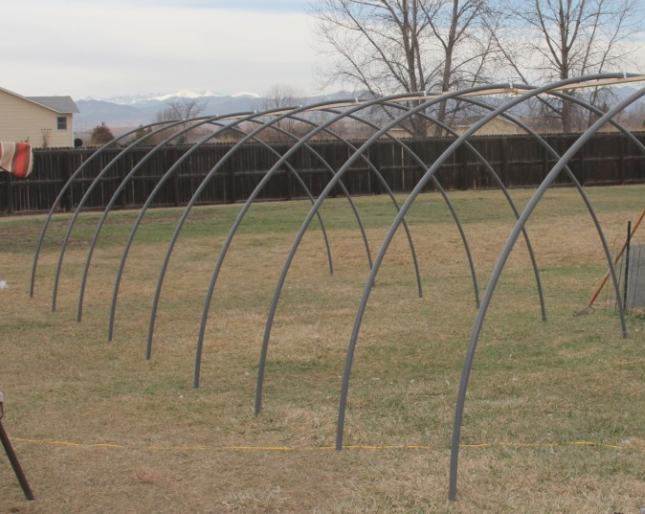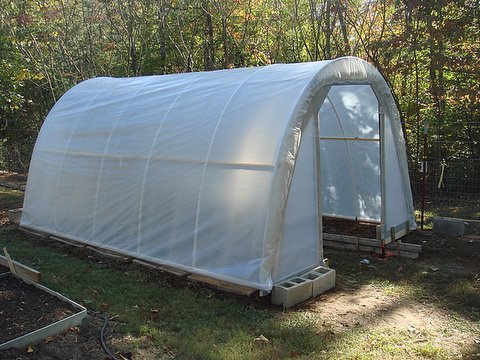To make a greenhouse with plastic sheeting, start by building a sturdy frame using wood or metal. Then, cover the frame with clear plastic sheeting, ensuring it is securely fastened.
Creating a greenhouse can enhance your gardening experience and extend your growing season. With the right materials and a bit of effort, you can build a functional greenhouse using plastic sheeting. This project is not only cost-effective but also straightforward, making it suitable for novice gardeners.
A greenhouse helps regulate temperature and humidity, providing a controlled environment for plants. By using plastic sheeting, you maximize sunlight exposure while protecting your plants from harsh weather. Follow these steps to create a greenhouse that meets your gardening needs and supports plant health year-round.

Credit: m.youtube.com
How to Make a Greenhouse With Plastic Sheeting : Step by Step Guide
Introduction To Greenhouse Gardening
Greenhouse gardening offers many advantages. A plastic sheeting greenhouse is cost-effective and easy to build. It provides warmth and protection for plants. This setup helps extend the growing season. Plants thrive in a controlled environment, leading to better yields.
Plastic sheeting is lightweight and allows sunlight to pass through. This material is also resistant to UV rays. It protects plants from harsh weather conditions. A well-constructed greenhouse can reduce pest problems. This helps keep plants healthy and vibrant.
| Key Considerations | Description |
|---|---|
| Location | Choose a spot with ample sunlight. |
| Size | Decide on the space based on your plants. |
| Ventilation | Ensure proper airflow to prevent overheating. |
| Support Structure | Use sturdy materials to frame the greenhouse. |
Choosing The Right Location
Choosing the right location for a greenhouse is very important. Sunlight plays a key role in plant growth. Look for a spot that gets full sun for most of the day. Avoid areas with too much shade from trees or buildings.
Next, evaluate the soil quality. Check if the soil drains well. Good drainage helps prevent water from pooling. Use a shovel to dig a small hole. If water collects, consider a different spot.
Also, test the soil for nutrients. Healthy soil supports plant growth. You can buy a soil testing kit at a garden store. Follow the instructions carefully for the best results.
Materials And Tools Required
To build a greenhouse, gather these materials:
- Plastic sheeting for covering
- Wood or PVC pipes for the frame
- Fasteners like screws or nails
- Hinges for doors
- Ground stakes for stability
Essential tools for assembly include:
- Saw for cutting materials
- Drill for making holes
- Screwdriver for fastening
- Tape measure for accurate measurements
- Level to ensure everything is straight

Credit: www.discountvisqueen.com
Designing Your Greenhouse
Choosing the right size and shape for your greenhouse is important. A larger greenhouse gives more space for plants. Think about the available area in your yard. Common shapes include rectangular, square, or arch-shaped designs.
Ventilation is crucial for plant health. Include windows or vents to allow air flow. Doors should be easy to open and close. A double door can help maintain temperature. Ensure doors are big enough for you to move inside easily.
Constructing The Frame
Start by choosing a strong material for the base. Wood or metal works well. Ensure the base is level and stable. Use anchors or stakes to secure it to the ground.
Next, measure and cut the frame pieces. Use rods or PVC pipes for a lightweight structure. Connect the pieces using screws or glue. Make sure the frame is rigid and well-supported.
Check the frame for any weak spots. Reinforce them with extra supports. This will help your greenhouse withstand wind and rain. A strong frame is essential for a successful greenhouse.
Applying The Plastic Sheeting
Start by measuring the area for your greenhouse. Cut the plastic sheeting to fit your frame. Make sure to leave extra material for overlap. Attach the plastic securely using staples or clips. This ensures it stays in place.
To seal the edges, use a strong adhesive tape. This will help prevent heat loss. Make sure to press down firmly on the tape. Check for any gaps or holes in the edges. Fill them with more tape if needed.
Proper sealing keeps your greenhouse warm. It also protects plants from harsh weather. Regularly inspect the plastic for wear and tear. Replace any damaged sections promptly.
Interior Setup And Planting
Arranging plants in your greenhouse is crucial for growth. Group similar plants together for better care. Leave enough space for air and light. Create pathways for easy access. This helps with watering and harvesting.
Temperature and humidity control is important for plant health. Use a thermometer to check the temperature regularly. Ventilation is key to preventing heat buildup. Open windows or use fans to improve airflow. For humidity, consider using a humidifier or misting system. Regularly check soil moisture to ensure proper levels.

Credit: www.tallahassee.com
Maintenance And Upkeep
Regular cleaning helps keep your greenhouse in great shape. Use a soft cloth or sponge. Clean the plastic sheeting with warm, soapy water. Rinse it off gently to avoid damage. This keeps sunlight shining through.
Check for any tears or holes in the plastic. Small repairs can be done quickly with tape. Look for areas where water collects. This can cause damage over time. Upgrade any old parts to improve efficiency.
Inspect the frame and foundation regularly. Make sure everything is sturdy and stable. Replace any rusty or weak parts. Taking care of your greenhouse helps plants grow better.
Expanding Your Greenhouse
Expanding your greenhouse can be easy and fun. Adding more space helps grow more plants. Use plastic sheeting to cover new areas. This creates a warm environment for your plants.
Consider these steps:
- Choose a sunny spot for your new space.
- Secure the plastic sheeting tightly to prevent wind damage.
- Ensure proper ventilation to keep the air fresh.
Incorporating advanced features makes your greenhouse even better. Think about adding:
- Automatic watering systems for convenience.
- Fans for air circulation on hot days.
- Temperature sensors to monitor conditions.
These features can help your plants grow faster and stay healthy.
Frequently Asked Questions
How Do You Build A Greenhouse With Plastic Sheeting?
Building a greenhouse with plastic sheeting is simple. First, choose a suitable location with ample sunlight. Construct a frame using wood or metal, then cover it with plastic sheeting. Secure the edges to prevent wind damage. Ensure proper ventilation for optimal plant growth.
What Materials Do You Need For A Plastic Greenhouse?
To create a plastic greenhouse, gather essential materials. You’ll need plastic sheeting, a sturdy frame, and fastening tools. Additionally, consider purchasing clips or clamps for securing the plastic. A door and ventilation system are also crucial for maintaining a healthy environment for your plants.
How Long Does Plastic Sheeting Last In A Greenhouse?
Plastic sheeting typically lasts between 4 to 6 years. The lifespan depends on quality, UV resistance, and environmental factors. Regularly check for wear and tear, especially after harsh weather. Replacing damaged sections promptly can extend the overall life of your greenhouse.
Can I Use Recycled Plastic For My Greenhouse?
Yes, recycled plastic can be used for greenhouses. Ensure it’s clear and UV-resistant to maximize sunlight penetration. While it may not be as durable as new plastic, it can still be effective. Just make sure to secure it properly to prevent tearing or degradation.
Conclusion
Creating a greenhouse with plastic sheeting is a rewarding project. It allows you to extend your growing season and protect your plants. With careful planning and the right materials, anyone can build one. Enjoy the process and watch your garden thrive year-round.
Start your greenhouse journey today!

